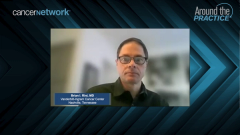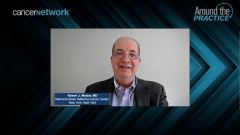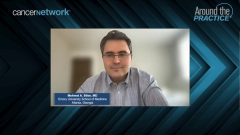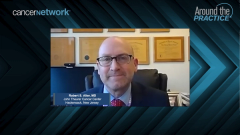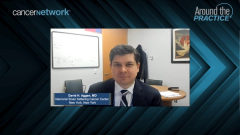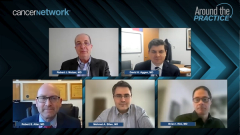
Is Adjuvant Pembrolizumab Standard of Care in Patients at Risk of Recurrence?
Considerations for whether adjuvant pembrolizumab is the new standard of care for patients with renal cell carcinoma at intermediate or high risk of recurrence.
Episodes in this series

Transcript:
Robert J. Motzer, MD: Bob, in terms of helping patients make informed decision, with the adjuvant pembrolizumab data, do you feel it is 1 size fits all? What factors go into your own recommendation for adjuvant pembrolizumab for patients?
Robert S. Alter, MD: Thank you, Bob. When I approach my patients, I utilize the eligibility for KEYNOTE-564 as options for my patients. That’s the eligibility I’d discuss my patients. Those are patients with stage II grade 4 disease, sarcomatoid differentiation, stage III or higher lymph node involvement, regional lymph node involvement, and even M1 disease and rendered NED [no evidence of disease]. Our experience dates maybe 5 years ago, when we had the S-TRAC data presented. We grabbed the opportunity to utilize an oral TKI [tyrosine kinase inhibitor], sunitinib, in patients who had high risk of recurrences. There were previous TKI studies using the earlier drugs, and they were all negative studies.
When the S-TRAC data came out, we were very excited. Shortly thereafter, we took a little a step back when we looked at the data a little closer. I’m very hard-pressed to consider that for our patients who are at high risk of recurrence. We have to look at our patients and be very aware of the toxicity profile. They saw on the clinical trial the fatigue, the diarrhea, and pruritus. You’re giving them immunotherapy, so the potential risks can be evident, as we’ve talked about.
Looking at the clinical trial, one-third of the patients had to come off because of toxicities. When you talk to your patients, though it does sound tempting at times, it can also sound toxic. It has to be a patient who is not only compliant but also strongly willed to recognize that they have to potentially endure toxicity. There are some risk factors and eligibility criteria that make it more evident that for someone who has M1-resected disease NED or nodal involvement, we tend to be a little more aggressive with this conversation with patients. Patients with stage II grade 4 are around the cusp. When you look at subset analyses in the future, we may see that if we further define these patients, they may not be at a significant benefit compared with patients who are more at higher risk.
A motivated patient is aware of the toxicities. My woman, who’s 82 years old and went on the therapy, was motivated because she’s the family member who wants to be active. She had an excellent support group. We allow many family members to come in on the first visit; otherwise, the cancer center is limited for visitors just because of COVID-19. The support network was there, and I still think we have to weigh the risk vs benefits. This adjuvant therapy definitely can postpone recurrences. It gives us a little conundrum about what to do if you fail an immunotherapy, what you use as first-line therapy on metastatic disease. But in my approach, the goal with the therapies is to postpone progression and even possibly cure the patients.
Robert J. Motzer, MD: Thanks very much. Brian, what’s your take on the data? Is this the new standard of care for patients? Are there any clinical pearls you can offer your colleagues in a community setting when they’re trying to make a decision on whether to use this therapy?
Brian I. Rini, MD: Yeah, it’s a new standard. I don’t know about clinical pearls. Like any therapy, we have to understand that there’s a relative benefit as evidenced by the hazard ratio, with a roughly 30% risk of reduction. As Bob was alluding to, for patients on the lower end of the risk who would have gotten into this trial, their risk of recurrence is probably only 20%. An absolute reduction might be about 5%. I talk about that with patients. I tend to recommend it more strongly the higher risk of recurrence they have—T3 node-positive, etc.
If they’re on the lower end of what would have made it into the trial, I still offer it, but I might be a little more tempered in my enthusiasm. I definitely talk about the small but real subset of patients who are going to have high-grade toxicity, require high-dose steroids, and potentially have lifelong toxicity, including endocrinopathies. When you look at median numbers for toxicity, it’s a little deceiving because if you’re that 1 of 10 patients who gets that bad toxicity, especially in the patient subset where half the patients are not destined to recur anyway, the risk-benefit is a little different. If there’s a survival benefit, until we know there’s an extra cure fraction, I may be a little guarded. But I wouldn’t disagree that it’s a standard of care, and I’m talking about it with all patients.
Robert J. Motzer, MD: There are a couple of other large phase 3 trials looking at I/O [immuno-oncology] therapy. Can you elaborate on those trials? Do you think they’re important for other options of therapy? Do you think they’re important for confirmation of the KEYNOTE-564 data? What’s your take in terms of those studies?
Brian I. Rini, MD: It’s important to remember this is the beginning of the story, not the end. As you said, there are other studies. The nice thing that’s maybe a little different from the TKI studies is that they’re all a little different: 2 involve CTLA4 inhibition, 1 has a neoadjuvant dose, 1 is a PD-L1 inhibitor. They all have a little different flavor. Unlike the sunitinib data, which came at the end of several negative studies, this era is kicked off with a positive study. Hopefully, the others have a similar theme and maybe offer different options. As we talked about, there are different I/O–TKI options. Maybe we’ll have different adjuvant options that are suitable to different patients, but over the next year or 2, we should start to get those other data in. It will add to the discussion.
Transcript edited for clarity.
Newsletter
Stay up to date on recent advances in the multidisciplinary approach to cancer.


